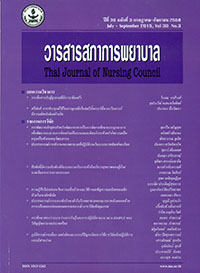ความรู้สึกไม่แน่นอนในความเจ็บป่วย และวิธีการเผชิญความเครียด ของเด็กป่วยโรคธาลัสซีเมีย
Keywords:
ความรู้สึกไม่แน่นอนในความเจ็บป่วย, วิธีการเผชิญความเครียด, เด็กป่วย, โรคธาลัสซีเมีย, illness-related uncertainty, coping strategies, children with thalassemiaAbstract
บทคัดย่อ: วัตถุประสงค์: เพื่อศึกษาความรู้สึกไม่แน่นอนในความเจ็บป่วยและวิธีการเผชิญ ความเครียดของเด็กป่วยโรคธาลัสซีเมีย
รูปแบบการวิจัย: การวิจัยเชิงบรรยาย
วิธีดำเนินการวิจัย: กลุ่มตัวอย่าง คือ เด็กป่วยโรคธาลัสซีเมีย อายุ 8-15 ปี ที่รับ การรักษาด้วยการให้เลือด ณ หอผู้ป่วยกุมารเวชกรรม โรงพยาบาลพะเยา ระหว่างเดือน มิถุนายนถึงเดือนกันยายน พ.ศ. 2557 จำนวน 40 คน เครื่องมือที่ใช้รวบรวมข้อมูล คือ แบบ บันทึกข้อมูลส่วนบุคคล แบบประเมินความรู้สึกไม่แน่นอนในความเจ็บป่วยของเด็กป่วยเรื้อรัง และแบบประเมินวิธีการเผชิญกับความเครียดของเด็กป่วยโรคเรื้อรัง วิเคราะห์ข้อมูลส่วน บุคคลและความรู้สึกไม่แน่นอนในความเจ็บป่วยโดยใช้สถิติเชิงพรรณนา วิเคราะห์วิธีการ เผชิญความเครียดโดยใช้คะแนนสัมพัทธ์ (relative score = r)
ผลการวิจัย: เด็กป่วยโรคธาลัสซีเมียส่วนใหญ่ ร้อยละ 95.00 มีความรู้สึกไม่แน่นอน ในความเจ็บป่วยระดับปานกลาง เลือกใช้วิธีการเผชิญความเครียดด้านการยอมรับมากที่สุด (r = 0.27) และใช้การหลีกเลี่ยงน้อยที่สุด (r = 0.09) โดยร้อยละ 55.26 มีความสามารถ ในการเผชิญความเครียดในภาพรวมได้ปานกลาง เด็กป่วยโรคธาลัสซีเมียส่วนน้อย ร้อยละ 2.50 มีความรู้สึกไม่แน่นอนในความเจ็บป่วยระดับสูง เลือกใช้วิธีการเผชิญความเครียดด้าน การมีปฏิกิริยาทางอารมณ์มากที่สุด (r = 0.26) และใช้การหลีกเลี่ยงน้อยที่สุด (r = 0.09) โดยร้อยละ 100.00 มีความสามารถในการเผชิญความเครียดในภาพรวมได้ไม่ค่อยดี
ข้อเสนอแนะ: พยาบาลหรือเจ้าหน้าที่ทีมสุขภาพที่เกี่ยวข้องควรเห็นความสำคัญเรื่อง ความรู้สึกไม่แน่นอนในความเจ็บป่วยของเด็กป่วยโรคธาลัสซีเมีย โดยเฉพาะกลุ่มที่มีความ ความรู้สึกไม่แน่นอนในความเจ็บป่วยในระดับสูง รวมทั้งควรจัดกิจกรรมที่จะช่วยส่งเสริม ให้ เด็กป่วยโรคธาลัสซีเมียสามารถใช้ วิธีการเผชิญความเครียดที่มีประสิ ทธิ ภาพอย่างต่อเนื่อง เพื่อช่วยลดความความรู้สึกไม่แน่นอนในความเจ็บป่วยของเด็กป่วยโรคธาลัสซีเมีย
Abstract: Objective: To examine the feeling of uncertainty in children with thalassemia and their coping strategies.
Design: Descriptive research.
Implementation: The subjects were 40 children aged between 8 and 15 who were suffering from thalassemia. The subjects were undergoing a blood transfusion in the paediatric ward of Phayao Provincial Hospital during June to September 2014. The data-collecting instruments were (i) a personal information form; (ii) an illness-related uncertainty assessment form for chronically ill children; and (iii) a stress coping strategy form for chronically ill children. The personal data and illness-related uncertainty data were analysed using descriptive statistics, whilst the coping strategy data were analysed using relative scores (= r).
Results: The major findings are as follows. Almost all (95%) of the subjects displayed a medium degree of uncertainty about their illness. The coping strategy most adopted by these subjects was ‘admittance’ (r = 0.27), whilst the least adopted strategy was ‘avoidance’ (r = 0.09). More than half (55.26%) of these subjects showed a moderate degree of overall stress-coping ability.
By contrast, 2.50% of the subjects showed a high degree of illness-related uncertainty. The coping strategy most adopted by these subjects was ‘emotional reaction (r = 0.26), and the least adopted strategy was ‘avoidance’ (r = 0.09). All of these subjects displayed a fairly low degree of overall stress-coping ability.
Recommendations: It is recommended that nurses or involved healthcare personnel pay closer attention to thalassemia children’s illness-related uncertainty, particularly those showing a high degree of such uncertainty. In addition, activities efficiently promoting ongoing development of stress-coping ability in children with thalassemia are also recommended as a means of reducing the patients’ illness-related uncertainty.







